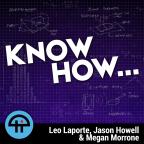
Jun 18th 2015
Know How... 148
Rockets, RRoD Fix, and Gasification
The Aerojet Rocketdyne RS-25.
The most powerful engine in the world, fix for the Red Ring of Death, how a Gassifier works, Hobbyking FPV kit, visualize the RF energy around you, and more.
Aerojet Rocketdyne RS-25
You've seen these before, they were known as the "SSME" or "Space Shuttle Main Engine"
-- It's a staged, liquid-fueled cryogenic rocket engine that was concieved of in the 60s, designed in the 70s and first flown in the 80s. * The fuel and oxydizer is first dumped into a small combustion chamber and ignited.
-- Those gasses are used to drive turbopumps which pressurize the fuel and oxydizer to be burned in the main combustion chamber
-- The exhaust from the small chamber is then dumped into the HighPressure manifold, adding to the thrust of the engine ** When we were first developing our rocket engines, we couldn't make a proper 2-stage engine. They kept blowing up. It's actually VERY tricky to exhaust the gases from the primary combustion chamber into the high-pressure manifold
-- So we would just waste that potential thrust
-- We learned how to do it properly from the Russians. It burns a combination of liquid hydrogen and liquid oxygen. - The engine can product 418,000lbs of thrust at liftoff.
** Fun Fact: the SRBs on the Space Shuttle generated 2,800,000 lbs of lift (83% of total thrust at liftoff) -- But the SRBs only provide lift for the Shuttle for 2 minutes while the 3 RS-25 engines continued to burn for 8.5 minutes. -- And since solid fuel burns unevenly, it created a "rougher ride" for the Shuttle astronauts than for, say-- the Apollo Astronauts.
** A total of 46 RS-25 engines were made, at a cost of $40 million each. -- They were reusable, so they would be refurbished and requalified after each flight. The exhaust from the RS-25 can reach temperatures of 3,315 degrees Celcius which is enough to BOIL iron... it would definitely destroy the nozzle
-- To prevent that from happening, the fuel (liquid hydrogen) is pumped through a series of small tubes in the nozzle to keep the material below melting.
-- The heated fuel is then released into the combustion chamber where it combines with the oxydizer (liquid O2) and products thrust.
** This engine, from 50 years ago! will be the future of space travel for the US -- It's the engine for the upcoming "Space Launch System"
Connect with us!
Don't forget to check out our large library of projects at http://twit.tv/kh.
- Google+ Community at gplus.to/twitkh
- Tweet at us at @padresj, @Cranky_Hippo and @Anelf3




